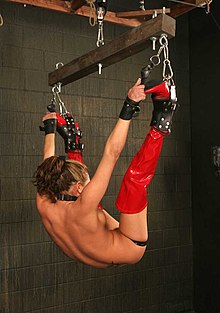
Bondage, in the BDSM subculture, is the practice of consensually tying, binding, or restraining a partner for erotic, aesthetic, or somatosensory stimulation. A partner may be physically restrained in a variety of ways, including the use of rope, cuffs, bondage tape, or self-adhering bandage.

Kinbaku (緊縛) means "tight binding", while Kinbaku-bi (緊縛美) literally means "the beauty of tight binding". Kinbaku is a Japanese style of bondage or BDSM which involves tying a person up using simple yet visually intricate patterns, usually with several pieces of thin rope (often jute, hemp or linen and generally around 6 mm in diameter, but sometimes as small as 4 mm, and between 7–8 m long. In Japanese this natural-fibre rope is known as asanawa. The allusion is to the use of hemp rope for restraining prisoners, as a symbol of power, in the same way that stocks or manacles are used in a Western BDSM context.

Handcuffs are restraint devices designed to secure an individual's wrists in proximity to each other. They comprise two parts, linked together by a chain, a hinge, or rigid bar. Each cuff has a rotating arm which engages with a ratchet that prevents it from being opened once closed around a person's wrist. Without the key, the handcuffs cannot be removed without specialist knowledge, and the handcuffed person cannot move their wrists more than a few centimetres or inches apart, making many tasks difficult or impossible.

Bondage cuffs are restraints designed for use in sexual bondage situations. Compared to conventional handcuffs, they are wide wrist and ankle restraints generally made of leather, often padded with soft leather or fake fur. Bondage cuffs may be fastened at the wrists and/or ankles by a locking mechanism, by a buckle or by velcro. They are secured around the wrist or ankle, and the cuffs may then be attached to each other or another object.

Self-bondage refers to the use of restraints on oneself for erotic pleasure. It is a form of erotic bondage which can be practiced alone.

A spreader bar is an article of bondage equipment usually consisting of a metal or wooden bar, with attachment points for bondage cuffs at each end, which can be fastened to wrists, ankles or knees to hold them apart. They are used in bondage play, and sometimes in bedroom bondage, usually in association with other bondage equipment.

The hogtie is a method of tying the limbs together, rendering the subject immobile and helpless. Originally, it was applied to pigs and other young four-legged animals.
Professional wrestling holds include a number of set moves and pins used by performers to immobilize their opponents or lead to a submission. This article covers the various pins, stretches and transition holds used in the ring. Some wrestlers use these holds as their finishing maneuvers, often nicknaming them to reflect their character or persona. Moves are listed under general categories whenever possible.

Bondage in BDSM, is the activity of tying or restraining people using equipment such as chains, cuffs, or collars for mutual erotic pleasure. According to the Kinsey Institute, 12% of females and 22% of males respond erotically to BDSM.

BDSM is a variety of erotic practices involving dominance and submission, roleplaying, restraint, and other interpersonal dynamics. Given the wide range of practices, some of which may be engaged in by people who do not consider themselves as practicing BDSM, inclusion in the BDSM community or subculture is usually dependent on self-identification and shared experience. Interest in BDSM can range from one-time experimentation to a lifestyle.

The spreadeagle is the position in which a person has their arms outstretched and legs apart, figuratively resembling an eagle with wings spread. It is a style that appears commonly in nature and geometry. In human style it is represented by the letter "X".

Cock and ball torture (CBT) is a BDSM or sexual activity involving the application of pain or constriction to the penis or testicles. This may involve directly painful activities, such as genital piercing, wax play, genital spanking, squeezing, ball-busting, genital flogging, urethral play, tickle torture, erotic electrostimulation, kneeing or kicking. The recipient of such activities may receive direct physical pleasure via masochism, or emotional pleasure through erotic humiliation, or knowledge that the play is pleasing to a sadistic dominant. Many of these practices carry significant health risks.

A gag is a device used in sexual bondage and BDSM roleplay. Gags are usually associated with roleplays involving bondage, but that is not necessarily the case. The person who wears the gag is regarded as the submissive partner, while the other is regarded as the dominant one. People may wear gags for a variety of reasons. Some people derive erotic pleasure from a gag, either in a submissive or dominant role. When combined with other physical restraints, the wearing of a gag can increase the wearer's sense of helplessness and anxiety level within a BDSM scene by rendering them unable to speak during sexual activity, which some people enjoy.

Body suspension means the act of rigging a human body to hang from implements that have been placed through temporary perforations in the skin.

Predicament bondage is a form of bondage in which a person is restrained and forced to experience opposing sensory forces. The default position is typically intended to cause muscle fatigue, such as standing on tiptoe, which forces the subject to choose a more physically painful position. For example, they may let themselves lower their weight and stand while forcing a rope to pull and painfully stretch their genitals. Predicament bondage can also involve the use of a single position in which remaining still will not cause any discomfort for the subject, but moving their body will pull on ropes, weights or other devices meant to cause them pain, or refer to not allowing the subject knowledge of how to escape, even if escape is possible or making the process of escape undesirable, such as forcing them to expose themselves publicly. The subject may then be tickled, sexually stimulated, or otherwise enticed to move uncontrollably.

Rope bondage, also referred to as rope play, kinbaku, shibari or fesselspiele, is bondage involving the use of rope to restrict movement, wrap, suspend, or restrain a person, as part of BDSM activities. Japanese bondage is the most publicly visible style of rope bondage. An alternative style, "Western bondage" is about achieving restraint; the Japanese style is more concerned with the artistry of the process. String bondage is the wrapping of rows of string around a body area for arousal. String bondage is also known as constrictions.

In horse tack, a panic snap is a mechanism often used between a lead and a horse harness or halter. They are useful because, unlike swivels or carabiners and similar fittings, they can be disconnected under load, as the panic snap is specially built so that the latching mechanism is separate from the load-bearing structure.

Breast torture is a BDSM activity in which sexual stimulation is provided through the intentional application of physical pain or constriction to the breasts, areolae or nipples of a submissive. It is a popular activity among the kink community. The recipient of such activities may wish to receive them as a result of masochism or they may have a desire to please a dominant who is sadistic. Those involved may also be motivated by breast fetishism. Mild breast torture such as light impact play on the breasts is also occasionally used outside of the BDSM context to provide stimulation and pleasure during conventional sex. While breast and nipple torture is usually performed on women, most techniques or methods may also be used on men.

An armbinder or monoglove is a type of restraint device primarily used in bondage play, designed to bind the arms and/or hands to each other or to the body, usually behind the back, and employing a range of bondage equipment including cuffs, rods, straps, and gloves.

A human pony harness is used for bondage - which can be for restraint, decoration and/or to facilitate work such as pulling a cart. It is usually made of leather but can be rope, biothane or other appropriate material. It is wrapped around the wearer's body in such a way that it cannot be slipped off. The wearer may have his/her hands strapped behind his/her back, although this is not usually recommended for pulling a cart or other work, in case of a fall. D-rings can be attached, so ropes or chains can be put on to lead the person around.























